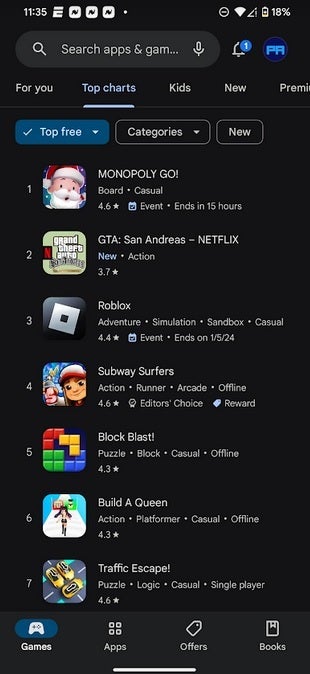Earlier this morning we updated a story we wrote on Monday evening about
the $700 million settlement that Google parent Alphabet made with 50 states, the District of Columbia, and two U.S. territories. Among the issues was the 15%-30% cut that
Google takes on in-app purchases made in the Play Store and the complexity of sideloading on Android. While the settlement was originally agreed to in September, the terms of the agreement were announced yesterday.
Play Store shoppers between 2016-2023 could be entitled to at least $2 each from the settlement
$630 million of the settlement will be handed out to consumers who will receive at least $2 each based on the amount of money they spent in the Play Store between Aug. 16, 2016, and Sept. 30, 2023. $70 million goes to the states for penalties, restitution, disgorgement, and fees.
Big-time changes are coming to the Google Play Store thanks to the $700 million settlement between Alphabet and the States
Google also promised to make changes to the Play Store and based on
court documents (via
9to5Google) we have an idea of what to expect. One of the possible changes will run for at least five years from the effective date and allow consumers to choose between using an alternative in-app billing system provided by the app developer or Google’s in-app payment processing platform when paying for the purchase of in-app digital goods and services.
Note that the decision of which payment processing service to you won’t belong to either Google or the developer, but will be the choice of the consumer. For six years, Google will be forced to allow developers to list the price of a digital good that can be bought outside of the app. Google won’t have to allow developers to put up a link to a site where the digital good could be bought, but developers will be allowed to write in the Play Store that the digital good is “available on our website for $9.99” or whatever price it is.
For example, let’s say that digital currency for a particular game is priced lower on the app developer’s site since there is no 30% Google Tax for the developer to pay if the purchase is made on the developer’s website. While there can’t be a link to that item outside if the Play Store, the developer can mention that it is available for a lower price from the developer’s site.
Android devices must support automatic background updates for apps installed from third-party sites
Again, based on court documents, Google will aim to make sideloading on Android easier. Sideloading, the process of installing apps from a third-party app storefront, will be reduced to a single page “by combining certain warning screens and updating user interface language, for at least five years.” The warning could say, “Your phone currently isn’t configured to install apps from this source. Granting this source permission to install apps could place your phone and data at risk.”
And to make sure apps that are sideloaded by an Android user remain up-to-date, for at least four years, Android devices will have to support automatic background updates of apps installed from third-party app stores.
The settlement prevents Google from entering into deals or enforcing deals with Android device manufacturers that would require the Play Store to be the exclusive Android app storefront preloaded on the home screen of devices. Google won’t even be allowed for five years to demand that it give consent before manufacturers pre-install third-party app stores on
Android phones.
It should be pointed out that the settlement still requires approval from a judge. The States are trying to get a particular judge to sign off on the settlement by February 8th. That judge is the one who recently presided over the Epic v. Google suit that resulted in a federal jury calling the Play Store a monopoly.

